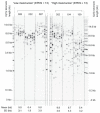Symptoms of Prenatal Depression Associated with Shorter Telomeres in Female Placenta
- PMID: 34299077
- PMCID: PMC8306199
- DOI: 10.3390/ijms22147458
Symptoms of Prenatal Depression Associated with Shorter Telomeres in Female Placenta
Abstract
Background: Depression is a common mood disorder during pregnancy impacting one in every seven women. Children exposed to prenatal depression are more likely to be born at a low birth weight and develop chronic diseases later in life. A proposed hypothesis for this relationship between early exposure to adversity and poor outcomes is accelerated aging. Telomere length has been used as a biomarker of cellular aging. We used high-resolution telomere length analysis to examine the relationship between placental telomere length distributions and maternal mood symptoms in pregnancy.
Methods: This study utilised samples from the longitudinal Grown in Wales (GiW) study. Women participating in this study were recruited at their presurgical appointment prior to a term elective caesarean section (ELCS). Women completed the Edinburgh Postnatal Depression Scale (EPDS) and trait subscale of the State-Trait Anxiety Inventory (STAI). Telomere length distributions were generated using single telomere length analysis (STELA) in 109 term placenta (37-42 weeks). Multiple linear regression was performed to examine the relationship between maternally reported symptoms of depression and anxiety at term and mean placental telomere length.
Results: Prenatal depression symptoms were significantly negatively associated with XpYp telomere length in female placenta (B = -0.098, p = 0.026, 95% CI -0.184, -0.012). There was no association between maternal depression symptoms and telomere length in male placenta (B = 0.022, p = 0.586, 95% CI -0.059, 0.103). There was no association with anxiety symptoms and telomere length for either sex.
Conclusion: Maternal prenatal depression is associated with sex-specific differences in term placental telomeres. Telomere shortening in female placenta may indicate accelerated placental aging.
Keywords: placenta; prenatal depression; sex differences; telomere shortening.
Conflict of interest statement
The authors declare no conflict of interest.
Figures



References
-
- Howard L., Ryan E., Trevillion K., Anderson F., Bick D., Bye A., Pickles A. Accuracy of the Whooley questions and the Edinburgh Postnatal Depression Scale in identifying depression and other mental disorders in early pregnancy. Br. J. Psychiatry. 2018;212:50–56. doi: 10.1192/bjp.2017.9. - DOI - PMC - PubMed
MeSH terms
Grants and funding
LinkOut - more resources
Full Text Sources
Medical

